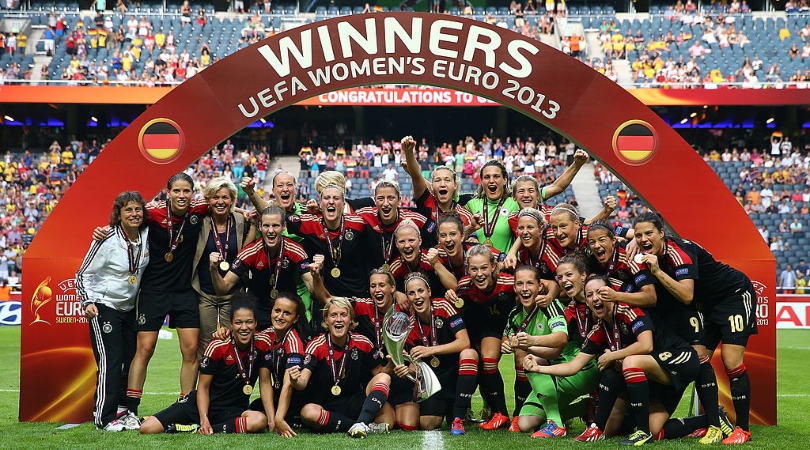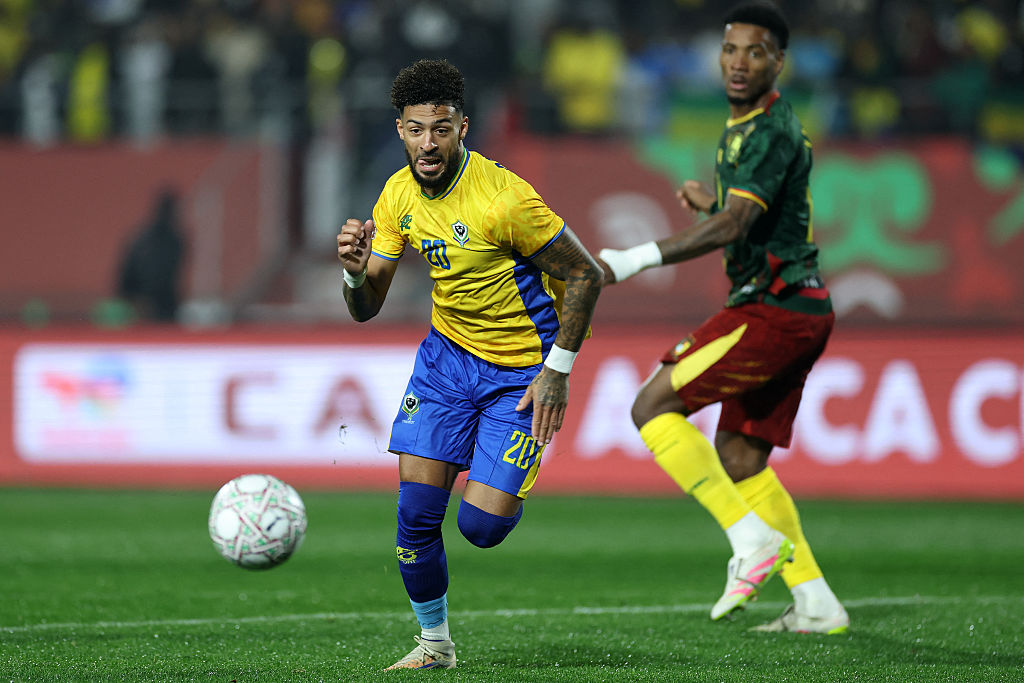From bans to professionalisation: How women's football in Europe has grown to peak popularity
Women's Euro 2022 has seen record-breaking attendances already – but how did European women's football get here?

Much like the men’s game, women’s football can trace its history back to Europe, and while some may already know of the Dick, Kerr company team who were the unofficial England national team 100-odd years ago, there are snatches of reports of women playing football elsewhere around the continent. Despite the bans that befell the women’s game – the 50 years of exile in England, a similar story in Scotland, while in Spain the ban came into effect in the 1930s, 20 years before Germany outlawed women playing football – Europe fast became a key player in the global game.
Unlike other areas around Europe, women’s football was much embraced in Scandinavia, and indeed why Danish, Norwegian and Swedish teams have featured prominently at major tournaments. With a number of the bans on women’s football finally, sensibly, ending in the 1970s, the women’s game was free from its shackles and, notably, it was the decade that saw the first very unofficial women’s tournaments.
With a league established in 1968, Italy was the veritable hot bed for women’s football as it began to emerge from its imposed slumber, and played host to both the first unofficial European Championship as well as the first unofficial Women’s World Cup. Not just the hosts in 1969, at the first ‘Euros’ – the tournament consisting of four matches played across Aosta Valley and Piedmont – Italy can claim the first-ever European title, having bested Denmark in the final. The first World Championship (also known as the Martini & Rossi Cup) followed the next year with the Danes overcoming the hosts in the final.
Although neither were sanctioned or recognised by either UEFA or FIFA, that didn’t stop the tournament from returning the following year, having been relocated to Mexico. Once again, Denmark were the victors, and although there are no solid records for the number of fans who turned out at the Estadio Azteca for the final, estimates start at 110,000 and zoom all the way up to 125,000 for those on hand to watch the Danes trump Mexico.
Over the next decade and a half, women’s leagues would continue to spring up across the continent with the European representatives at the ensuing unofficial tournaments. Italy claimed three of the five ‘Mundialitos’ (little World Cup) throughout the 1980s, England were the other victors before the competition was scrapped at the end of the decade. There is, in fact an argument that Italy and Denmark were just a little too ahead of their time, the dominant forces on the world stage beginning to flame out by the time UEFA and FIFA began to take women’s football seriously. From contesting the last unofficial European Championships in 1979, Italy (the runners up in Naples) would feature in two more Euro finals in the 1990s, but fast fell out of the reckoning. Worse still, victors in ’79, Denmark, wouldn’t make it back to another Euro final until 2017, oft eclipsed by Scandinavian siblings, Norway and Sweden.
While the USA began to rule the roost on the global stage, and could certainly not boast much in the way of competition for their American crowns in CONCACAF or CONMEBOL, Europe (much like Asia) saw teams rise and fall, the guard constantly being changed. With Italy and Denmark’s dominance receding, Norway became the temporary darlings of Europe, with stars like Linda Medalen and Hege Riise delighting fans at the first (unofficial official) World Cup in 1991, as well as the first official Euros in the late 1980s. Very much relying on one generation of talent, Norway’s time in the limelight was brief, the team unable to keep parity as Germany began their rise, like the proverbial cream, to the top.
All-conquering in Europe, Germany became the first nation to win back-to-back Women’s World Cups (12 years before the USA managed the feat). Yet, despite their wins in 2003 and 2007, Die Nationalelf couldn’t build on this success at their home World Cup in 2011 and have not managed to pick up a medal at a World Cup since 2007. The German team have, however, had more than their fair share of success at the other two major tournaments in women’s football: the Euros and the Olympics. The three Olympic bronze medals (won from 2000-2008) were finally bettered in an all-European final in Rio in 2016, when they overcame Sweden 2-1 to claim gold.
The best features, fun and footballing quizzes, straight to your inbox every week.
It’s the Euros where Germany have flexed their muscles the most over the years, swatting away almost every challenge they’ve faced since their first outing in 1989. A loss to Italy (on penalties) in the semi-finals in 1993, the only blot on their record of eight titles from nine championships, until they were knocked out by Denmark in the quarters in 2017. Despite most nations not being able to get the better of Germany at the Euros, countries like France, England and Spain have built up strong national teams, investment playing a significant part in driving the growth both domestically and internationally.

Despite the mini-boom of women’s football in the 1970s, the growth of the domestic game has been a slow one and although nations like Denmark and France can trace the start of their home leagues back to 1974, countries like Sweden and Spain would have to wait until 1988. Even for a prominent country like Germany, it would take until 1990 for the Frauen-Bundesliga to be established and like so many before it, it would need to undergo reformatting for it to become what we know it as today.
Rather mirroring their success on the international stage, Germany and their European bridesmaids, Sweden, were the two main beneficiaries from the newly founded UEFA Women’s Cup at the turn of the century. Umeå IK – a team from Sweden’s frozen north – had the distinction of being the first team to lose a European final when they were bested 2-0 by FFC Frankfurt in 2002. The final was the only one of the ‘Women’s Cup’ era to be played as one 90-minute match, rather than a two-legged final, as the subsequent seven were before the competition was reformatted to become the Women’s Champions League.
It wouldn’t be the last fans would hear of Umeå though, as they would go on to win the next two finals, first beating Danish side Fortuna Hjørring – having dispatched with Frankfurt in the semi-final, before thrashing the Germans 8-0 on aggregate the following season, with an 18-year-old Marta scoring three over the two legs. Yet it wasn’t just Umeå and Frankfurt. The following season saw two different Swedish and German representatives in the showpiece final, this time with Turbine Potsdam (like FFC Frankfurt, an independent team) beating Djurgården/Älvsjö (now Djurgården, the women’s section of the men’s team from Stockholm). Potsdam would be back the following season, this time losing to Frankfurt in an all-Frauen-Bundesliga final. Umeå returned to the finals in 2007 and 2008, losing both, first to Arsenal – the 1-0 win for the Gunners still the only European title for an English team – then to Frankfurt, marking the beginning of the end for a team fast running into financial problems.
FCR Duisburg would claim the final UEFA Women’s Cup in 2008/09 before the reformat, and their own demise, insolvency once again claiming another women’s club.
By the time of the first UEFA Women’s Champions League final, there was a new kid on the block. Although they lost that first final, their first final, Olympique Lyonnais Féminin were here to stay. Having lost to Potsdam that first season, Lyon defeated their German foes the next season before handing Frankfurt the same fate, in front of over 50,000 fans at the Olympiastadion in Munich in the 2011-12 final.
The emergence of VfL Wolfsburg in Germany, ushered in the end of Frankfurt and Potsdam’s dominance, the balance of power shifting with the increased investment from teams like Wolfsburg and Lyon. Looking to break the Franco-German dominance, short-lived Swedish outfit Tyresö managed to reach the final in 2014, their star-studded team only just out-muscled 4-3 by the Wolves. The final was the highpoint for a team that injected too much money too quickly and just 33 days after their loss to Wolfsburg, declared bankruptcy.
Although teams like Tyresö and former Italian giants, Torres, paid the price of having plans that were bigger than their bank accounts, other independent outfits found a way to exist in an increasingly expensive sport. As can be seen in Germany, FFC Frankfurt have been absorbed into Eintracht Frankfurt and are enjoying more stability after falling off the pace in the Frauen-Bundesliga, while Potsdam have soldiered on as a lone entity, although one that has found itself off of the pace in the league.
In Italy, a mandate from FIGC has seen Serie A men’s clubs buying up the Serie A (Femminile) licences of pre-existing teams – such as Brescia being bought by AC Milan or Juventus picking up Cuneo’s licence – the move in-line with the full professionalisation of the league starting in 2022/23. The Italian model is very much where the game is heading across Europe’s richer leagues, not just to give fair opportunities for girls and women to play professional football, but also simply as a way of keeping pace.
A lot has been said about Lyon’s dominance in the Champions League – the French giants having claimed eight European titles – but for their strength in Europe, as well as domestically, Les Lyonnaises are the team that have set the pace for the whole continent. Lyon’s success didn’t come overnight, but as soon as Jean-Michel Aulas decided to invest in his women’s team, and treat them the same as the men’s team at Lyon, their success was inevitable. Indeed, Lyon have become the blueprint for sustained success in the women’s game, the players not just commanding some of the biggest salaries but given the facilities and help they need to succeed on the pitch.
There can be no question that Lyon rose to become the queens of Europe, but it is true that at the start of their ascent, few teams could match what they were doing off the pitch. The team who have claimed 14 Division 1 Féminine titles (and who are in pole position for a 15th), have done so in a deeply polarised league – although it’s worth noting that closest rivals, Paris Saint-Germain, have only managed to lift the French title once [in 2020/21] – and indeed, across a polarised continent. The majority of teams who play in Europe are not full-time, and even those who boast ‘professional’ football often do so on a sliding scale, the fortunes at the top of the English Women’s Super League (one of the few full-time leagues) very different from those at the bottom. But we are seeing more competition and instead of two teams (Lyon and Wolfsburg), the latter stages of the Women’s Champions League have mirrored the men’s competition with the likes of Bayern Munich and Real Madrid getting amongst it.
The professionalisation of the Spanish league, currently known as the Primera División or Primera Iberdrola, has been one of the major game-changers in women’s football in Europe. Although WSL can boast talented players from around Europe, just as the top two in France and Germany can, there is an added air of opportunity in Spain. A league that has long imported players from South America as well as a notable handful from Africa and Asia, it is a happy mix of established men’s clubs as well as smaller or independent teams.
Away from Barcelona’s dominance, the rest of the league exists in flux, most teams unable to climb to the top of the tree and stay there for an extended period of time, such is the healthy competition. Even Barcelona’s bitter rivals, Atlético Madrid, have faltered since their third successive title in 2019.
The team to beat in Spain for so long, Barcelona moved to a professional setup ahead of the 2015/16 season, with their eyes focused on the Champions League, but this seemed to cause more issues than it solved for the Catalans as they missed out on the next four league titles. Worse still, the domestic silverware was never too far out of reach for Barcelona, the team failing to claim the league title in 2016 by one point, 2017 by three, 2018 by one point again, before finishing six points adrift at the end of the 2018/19 season. Always in the mix, Barcelona’s biggest weakness seemed to reside between their ears, finding mental resilience and self-belief the trickiest of hurdles to navigate.
Remembered for their resounding loss to Lyon in the 2019 Champions League final, those around the team have since admitted, for them, simply getting to the final had been their final. Conceding four goals in the first half hour, Barcelona still clearly had work to do off the pitch, but it would only take another two years for them to return to the final, clearly as the strongest team on the continent. Having regained their Spanish crown, the Catalans easily dispatched with Chelsea in the final, effectively ushering in a new era of women’s football in Europe, making everyone sit up and take notice not just of themselves, but of all Spanish women’s football.
Setting a new world record attendance for a (FIFA recognised) women’s football match in the competition (twice) this season, Barcelona are forging a clear path for women’s football. Not just a professional team, or one that can sell out one of the biggest men’s stadiums, by playing the Barcelona way, the team has legitimised women’s football as something that can be as beautiful, heart-racing and captivating as the men’s game. Regardless of whether this season’s Champions League trophy stays in Spain or if Lyon regain it, the European game is the healthiest it’s ever been.
This article first appeared in the Ultimate Guide to Women’s Football, available with free delivery now, or in WH Smiths in the UK and Barnes & Noble in the US
